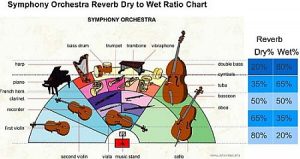For example if you are using 3 mono channels on the mixer for mixing 3 tracks (e.g. one vocal, one lead guitar and one rhythm guitar); you can control the amount of dry signal to be sent to the reverb unit from each channel by using the aux send EFX knob.
Controlling the amount of Reverb Effect that you want for each channel
In some reverb unit such as Lexicon MX400, the amount of reverb effects that you want in the channel depends on the amount of dry signal going into the unit. This means that higher aux send EFX setting in particular channel also corresponds to higher reverb applied on the signal. Let’s have a practical example, supposing you are mixing symphony orchestra music with dry and wet ratio setting assigned as follows:
(Taken from this tutorial: Symphony orchestra panning and reverb settings)
There are 5 distinct dry to wet ratio that you wish to assign:
1.) 80% dry, 20%wet
2.) 65% dry, 35% wet
3.) 50% dry, 50% wet
4.) 35% dry, 65% wet
5.) 20% dry, 80% wet
OK, here is how to set them. First, if the entire aux send EFX knobs in all channels are set to 0, you are not sending any dry signals to the reverb unit and the entire mix will be dry (no reverb effect applied). Supposing a 0% knob (minimum or zero) corresponds to 100% dry, 0% wet and full knob setting corresponds to 0% dry and 100% wet then the above dry and wet ratio can be implemented as follows:
1.) 80% dry, 20%wet =20% aux send EFX
2.) 65% dry, 35% wet = 35% aux send EFX
3.) 50% dry, 50% wet = 50% aux send EFX
4.) 35% dry, 65% wet = 65% aux send EFX
5.) 20% dry, 80% wet = 80% aux send EFX
Therefore you can say that the %wet (reverb) that you want in each channel is proportional to the aux send EFX settings.
Content last updated on August 5, 2012
